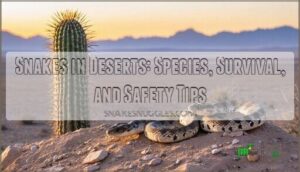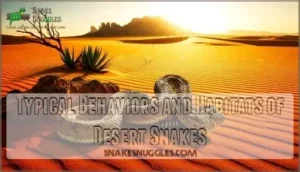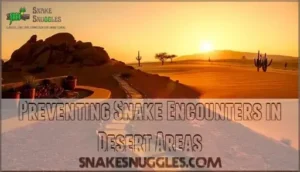This site is supported by our readers. We may earn a commission, at no cost to you, if you purchase through links.
 A rattlesnake coiled beneath a prickly pear doesn’t care about your hiking plans—it’s just trying to survive another scorching afternoon in the desert. Snakes in deserts have mastered one of Earth’s harshest environments through exceptional adaptations, from heat-sensing pits that detect prey in total darkness to the ability to go weeks without water.
A rattlesnake coiled beneath a prickly pear doesn’t care about your hiking plans—it’s just trying to survive another scorching afternoon in the desert. Snakes in deserts have mastered one of Earth’s harshest environments through exceptional adaptations, from heat-sensing pits that detect prey in total darkness to the ability to go weeks without water.
Yet despite sharing these arid landscapes with us, most people can’t tell a venomous sidewinder from a harmless gopher snake. Understanding which species live in desert regions, how they’ve adapted to extreme temperatures, and what draws them to certain areas can mean the difference between a safe outdoor experience and a dangerous encounter.
Table Of Contents
- Key Takeaways
- Snake Species Found in Desert Environments
- How Desert Snakes Survive Harsh Conditions
- Typical Behaviors and Habitats of Desert Snakes
- Preventing Snake Encounters in Desert Areas
- Staying Safe Around Desert Snakes
- Frequently Asked Questions (FAQs)
- Does a snake live in the desert?
- Can you find a snake in the desert?
- Why do snakes bury themselves in the desert?
- Which desert has the most snakes?
- How do desert snakes conserve water?
- What are common prey for desert snakes?
- How do snakes detect vibrations?
- Do desert snakes use camouflage techniques?
- What are nocturnal habits of desert snakes?
- What predators naturally hunt desert snakes?
- Conclusion
Key Takeaways
- Desert snakes survive extreme heat through thermoregulation (basking and burrowing to maintain 28–32°C), nocturnal hunting patterns, and seeking thermal refuges like rock crevices and abandoned rodent burrows when temperatures become lethal.
- Rattlesnakes can be identified by their triangular heads, heat-sensing pits between eyes and nostrils, and segmented rattles, while defensive behavior includes coiling and tail vibration—backing away slowly when you hear the rattle prevents most dangerous encounters.
- Reducing snake encounters requires eliminating attractants through yard maintenance (removing debris, trimming grass, sealing foundation gaps), controlling rodent populations, and using physical barriers like snake-proof fencing buried at least 4 inches deep.
- If bitten by a rattlesnake, immediately immobilize the limb below heart level, wash the wound, apply a cool compress, and get to a hospital with antivenom without delay—never tourniquet or cut the bite site.
Snake Species Found in Desert Environments
Desert snakes come in all shapes and sizes, from harmless wanderers to venomous rattlers that demand your respect. Knowing which species call the desert home—and what makes them tick—can keep you safe and help you appreciate these often-misunderstood creatures.
Let’s break down the key players you’re likely to encounter.
Common Desert-Dwelling Snakes
When you think "desert snake," rattlesnakes probably come to mind first—and you’re not wrong, but they’re just the headline act in a much bigger cast of sun-loving serpents. Gopher snakes, coachwhips, and glossy snakes also thrive in arid habitat diversity, each playing distinct roles in desert ecosystem balance.
These species showcase impressive desert snake adaptations, from burrowing techniques to heat tolerance, that allow both venomous snakes and nonvenomous snakes to coexist across varied snake habitat types.
Venomous Vs. Non-Venomous Species
Knowing the difference between venomous snakes and nonvenomous snakes can literally save your life—or at least spare you a lot of panic. Snake morphology gives you the first clues: triangular heads and slit pupils often signal venom delivery systems in pit vipers, while rounded heads and round pupils suggest you’re looking at a harmless species.
Here’s what sets them apart:
- Venom potency varies wildly—rattlesnakes pack medically significant toxins, while many desert dwellers are completely harmless
- Defensive mechanisms like rattling, coiling, and hissing warn you before venomous snake encounters escalate
- Species classification matters: kingsnakes mimic rattlers but actually hunt them
- Snake behavior differs—nonvenomous species usually flee; venomous ones may stand their ground
- Snake safety starts with recognizing these patterns before you get too close
Understanding these differences isn’t just academic—it shapes how you respond when you cross paths with desert serpents. Recognizing snake bite symptoms is essential for effective treatment and survival.
Regional Distribution in Oregon and Beyond
Oregon snake maps reveal rattlesnakes stretch across the Columbia Plateau and Great Basin, with the Western Rattlesnake dominating desert ecosystems in south-central and southeastern regions.
Snake distribution extends beyond state borders—populations reach eastern Washington, northern California, and even southern British Columbia’s Okanagan Valley. Regional wildlife habits show these border species migrate between dens and hunting grounds, making regional conservation efforts critical for rattlesnakes and other desert-adapted serpents throughout the interconnected landscapes of the Pacific Northwest.
Understanding the snake species is essential for effective conservation and safety measures.
How Desert Snakes Survive Harsh Conditions
Desert snakes don’t just survive the heat—they’ve mastered it through some pretty clever adaptations. From how they control their body temperature to when they choose to move around, these reptiles have figured out what works in extreme conditions.
Let’s look at the three main ways they pull it off.
Thermoregulation and Ectothermic Behavior
Desert snakes can’t make their own heat, so they’re masters at borrowing it from their surroundings. You’ll find them basking on rocks or tucked underground, chasing that ideal range between 28–32°C.
Body temperature drives everything—hunting, digesting, even dodging danger. Too cold? They vanish below 15°C. Too hot? They retreat to shade.
This ectothermic regulation keeps venomous snakes like rattlesnakes thriving where others would wilt, balancing thermal adaptation with desert thermoregulation to fuel their metabolism and snake behavior.
Sheltering: Burrowing, Rock Crevices, and Shade
When the sun turns rocks into griddles, desert snakes slip into an underground world of burrows, crevices, and shadowed hideaways. These thermal refuges offer snake safety from lethal heat:
- Abandoned rodent burrows providing cool, stable microclimates
- Rock crevices between boulders where rattlesnakes den communally
- Desert denning sites under fallen logs or dense vegetation
- Shaded overhangs along canyon walls
- Burrow architecture they excavate themselves in softer soils
Understanding shade preference helps you predict snake encounters during field work.
Nocturnal Activity Patterns
As soon as dusk softens the heat, most desert snakes emerge from their hiding spots to hunt, patrol, and prowl through the cooler darkness. Nocturnal behavior transforms rattlesnakes into efficient predators—nighttime hunting relies on heat-sensing pits and enhanced snake vision adapted for low light.
You’ll notice increased moonlight activity near water sources and rodent trails, where desert navigation guides them to prey, making snake encounters more likely during evening hikes.
Typical Behaviors and Habitats of Desert Snakes
Desert snakes aren’t just drifting through sand—they’re following a pattern you can read once you know what to look for.
Water, food, and the other creatures they share space with shape where they go and how they hunt.
Here’s what drives their day-to-day behavior in these unforgiving places.
Attraction to Water and Food Sources
If you think snakes wander the desert aimlessly, you’re missing the bigger picture—they’re laser-focused on two things that keep them alive: water and prey. Rattlesnakes and other desert species track moisture to leaky faucets, pet dishes, or standing water—these water sources become survival hotspots.
Food attraction works the same way: rodents, birds, and lizards draw snakes into specific snake habitats, shaping desert ecology through survival tactics rooted in snake behavior and habitat needs.
Hunting Techniques and Diet
Rattlesnakes don’t chase their meals—they’re ambush predators that strike with precision, relying on heat-sensing pits and venom to take down prey before it even knows what hit it. Their venomous diet includes small mammals, birds, and lizards—snake prey they detect through thermal imaging and vibration.
These hunting strategies define snake behavior and habitat in desert foraging zones, where predator avoidance by prey shapes every encounter, making rattle snakes masters of patience and calculated strikes in venomous snakes territory.
Interactions With Other Wildlife
Desert wildlife doesn’t just tolerate rattlesnakes—some species actively hunt them, while others serve as unwitting prey or accidental alarm systems that shape the entire food web. Roadrunners and honey badgers are legendary snake predators, while prey animals inadvertently signal danger through wildlife corridors.
These animal adaptations maintain ecosystem balance, informing wildlife management strategies and reptile control efforts that respect wildlife conservation while addressing snake encounters and safety through natural animal deterrents in desert ecology.
Preventing Snake Encounters in Desert Areas
You don’t have to share your desert home with rattlesnakes if you take a few smart precautions. From keeping your yard tidy to enlisting some unexpected four-legged help, there are practical ways to make your property less inviting to these reptiles.
Here’s what actually works when you want to reduce your chances of crossing paths with a snake.
Yard Maintenance and Debris Removal
Your yard might as well roll out a welcome mat for snakes if you’re leaving woodpiles, tall grass, and junk scattered around—they see that clutter as prime real estate. Here’s your yard maintenance for snake control checklist:
- Trim grass short and clear debris regularly—outdoor safety tips start with yard sanitation
- Stack firewood off the ground and away from structures
- Remove standing water and fix leaky outdoor fixtures
- Seal gaps under sheds, porches, and foundations for outdoor sealing
- Design your landscape with open spaces and minimal ground cover—thoughtful landscape design creates natural snake barriers
Regular debris cleanup disrupts their shelter options. Snake prevention methods work best when you’re consistent about yard maintenance.
Animal-Based Snake Deterrents (Terriers, Chickens, Etc.)
Some folks skip the chemicals and bring in living, breathing backup—terriers, chickens, guinea hens, and even peacocks have earned reputations as natural snake deterrents that patrol your property with instinct on their side. Terriers excel at snake repellent duty through predator training, while chickens behind proper chicken fencing create noise and movement that discourage snakes.
Dogs need animal safety protocols, but these guard animals offer a proactive approach to keeping snakes at bay without relying solely on commercial products.
Repellents, Fencing, and Sealing Entry Points
Beyond the cluck and cackle of guard animals, you can harden your perimeter with physical barriers and chemical repellents that turn your property into less welcoming territory for wandering snakes.
- Snake-proof fencing with buried mesh (at least 4 inches deep) blocks entry along your yard perimeter
- Naptha-based snake repellents create chemical boundaries snakes won’t cross
- Seal gaps under doors, vents, and foundation cracks—snakes slip through openings as narrow as a quarter-inch
- Combine barrier installation with pest control measures to eliminate rodent food sources
- Professional wildlife management teams manage snake removal when DIY efforts fall short
Staying Safe Around Desert Snakes
You can share space with desert rattlesnakes without drama, but it takes awareness. Knowing what to watch for, how to respond if something goes wrong, and a few smart strategies can keep you and your pets out of trouble.
Here’s what actually works when you’re living or hiking where rattlesnakes call home.
Recognizing Rattlesnakes and Warning Signs
That triangular head, the heat-sensing pits below the nostrils, and the tell-tale rattle—these are your field marks when you’re trying to sort a rattlesnake from a harmless gopher snake in the wild. Watch their behavior too: rattlesnakes coil defensively and vibrate that tail when threatened, while non-venomous species often flatten their heads to mimic the threat.
| Feature | Rattlesnake | Harmless Snake |
|---|---|---|
| Head shape | Triangular, distinct from neck | Narrow, tapered |
| Heat pits | Present between eye and nostril | Absent |
| Tail | Segmented rattle or button | Tapered, no rattle |
Rattlesnake identification saves lives. In Oregon, encounters peak during summer months in eastern regions. These venomous snakes usually avoid confrontation—they’ll retreat if given space. But if you corner one accidentally, you’ll hear that unmistakable buzz. That’s your cue to back away slowly, giving the animal room to escape.
First Aid and Medical Response to Bites
If you’re bitten, time matters—snake bite symptoms escalate fast. Keep calm and immobilize the limb below heart level to slow venom spread. Here’s what to do immediately:
- Wash the wound with soap and water
- Apply a cool, clean compress
- Get to a hospital equipped with antivenom—92.6% of healthcare professionals agree transport shouldn’t be delayed
Don’t tourniquet or cut the bite. Antivenom dosage depends on your body’s response, and early intervention drastically improves outcomes for rattlesnake behavior-related injuries.
Training Dogs to Avoid Snakes
Dogs who’ve never met a rattlesnake won’t naturally steer clear—they need conditioning to pair that scent with danger. Canine Snake Avoidance programs use Remote Collar Training with dead snakes, teaching Avoidance Behavior Patterns through controlled exposure. Snake Detection Techniques reinforce Outdoor Safety instincts, reducing Snake Encounters dramatically.
| Training Method | Success Rate | Risks |
|---|---|---|
| Remote collar + dead snake | High reinforcement | Requires multiple sessions |
| Scent conditioning | Moderate retention | May fade over time |
| Field exposure drills | Real-world readiness | Unexpected bites still possible |
Legal and Ethical Considerations in Snake Handling
Relocating or managing a rattlesnake isn’t just risky—it often breaks state wildlife laws, since most jurisdictions protect native species and restrict who can touch them. Rattlesnake laws in Oregon require Permit Requirements for moving venomous snakes, protecting Snake Welfare under Wildlife Protection statutes.
Management Laws and Conservation Ethics mean you can’t kill or capture them without authorization. Ignoring snake management rules raises Liability Concerns—getting bitten while breaking the law won’t help your case.
Frequently Asked Questions (FAQs)
Does a snake live in the desert?
Imagine a sidewinder rolling across sun-scorched sand like a ribbon tossed by wind—yes, many snakes thrive in desert ecosystems.
Arid zone snakes have evolved extraordinary adaptations for survival in extreme heat, making desert snake habitats surprisingly diverse across venomous and non-venomous species.
Can you find a snake in the desert?
Absolutely—deserts are prime real estate for snakes. Desert snake tracking reveals they’re drawn to rocky outcroppings, rodent burrows, and water sources. Snake habitat analysis shows species like rattlesnakes thrive here, mastering snake behavior patterns through nocturnal hunting.
Desert wildlife encounters happen often, so follow desert safety tips: watch your step and respect their space.
Why do snakes bury themselves in the desert?
Snakes burrow to escape extreme heat and cold, a form of thermal regulation that keeps their bodies from overheating or freezing.
Sand shelter also provides desert camouflage from predators and helps them ambush prey.
Rattlesnakes and other desert-dwelling species use this survival strategy year-round.
Which desert has the most snakes?
When it comes to Desert Snake Density and Arid Ecosystems, pinpointing which desert reigns highest is tricky—data isn’t thorough. However, the Sonoran Desert (Arizona/Mexico) likely leads, boasting outstanding Desert Biodiversity, including numerous Rattlesnake distribution zones.
Making Hotspot Analysis and Snake safety critical for Wildlife in Oregon visitors exploring southwestern landscapes.
How do desert snakes conserve water?
Reptiles excel at moisture retention through specialized kidneys that produce concentrated uric acid instead of liquid urine. Their scales prevent water loss, and many species absorb moisture from prey.
Some rattlesnakes can survive months without drinking by relying on metabolic water from digestion.
What are common prey for desert snakes?
Most desert snakes feed on small mammals like mice and rats, providing natural rodent control.
Lizards, birds, and insects also make up their diet depending on species and availability in wildlife-rich areas.
How do snakes detect vibrations?
You can feel vibrations through your jawbone when you rest your chin on a surface—snakes do something similar.
Snakes sense ground vibrations through their lower jaw, much like you’d feel sound through your chin pressed to a surface
They detect ground vibrations through their lower jaw, which connects to inner ear bones that sense seismic waves and vibrational cues, alerting them to approaching predators or prey.
Do desert snakes use camouflage techniques?
Blending into the background is practically second nature for most desert snakes. Their color patterns match surrounding sand, rocks, or vegetation, making them nearly invisible to predators and prey.
Rattlesnakes excel at concealment strategies, using mottled browns and tans that mirror desert terrain—an essential desert adaptation for survival.
What are nocturnal habits of desert snakes?
When darkness falls, you’ll find these reptiles shift into hunting mode. Nocturnal behavior helps them regulate body temperature while stalking rodents and lizards.
Rattlesnakes navigate using heat-sensing pits, detecting warm prey even in complete darkness—essential for survival.
What predators naturally hunt desert snakes?
Several animals have adapted to hunt desert snakes effectively. Roadrunners use speed and agility to kill rattlesnakes, while honey badgers possess immunity to venom.
Peacocks and snake eagles attack from above, and foxes hunt smaller species opportunistically.
Conclusion
A century from now, your great-grandchildren will still be sharing stories about snakes in deserts—because these reptiles have outlasted civilizations and will outlast us too. They’ve perfected survival in conditions that would kill most creatures within hours.
Your respect for their adaptations, paired with smart prevention and awareness, keeps both species thriving. The desert belongs to them first. We’re just passing through their territory, and knowing that changes everything about how we walk, camp, and build there.
- https://skyislandalliance.org/wp-content/uploads/2024/03/Introduction-to-Tucson-Area-Snakes.pdf
- https://en.wikipedia.org/wiki/List_of_dangerous_snakes
- https://www.medsciencegroup.us/articles/ATTE-3-104.php
- https://www.snakesnap.co/snakes-of-oregon
- https://ashlandorgardenclub.org/wp-content/uploads/2017/08/oregon_living-with-snakes.pdf













